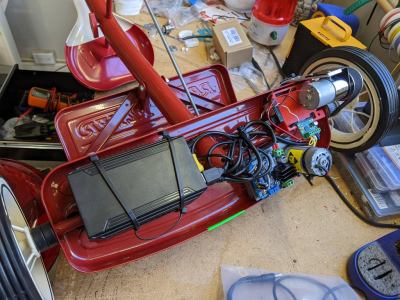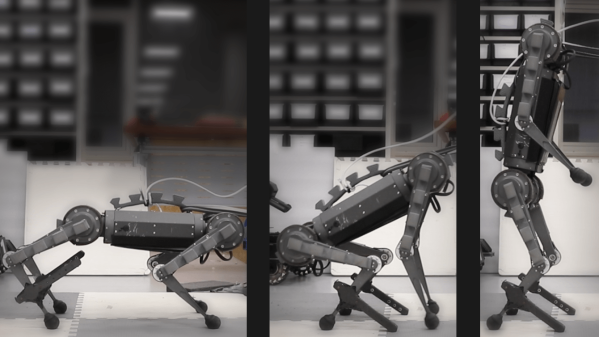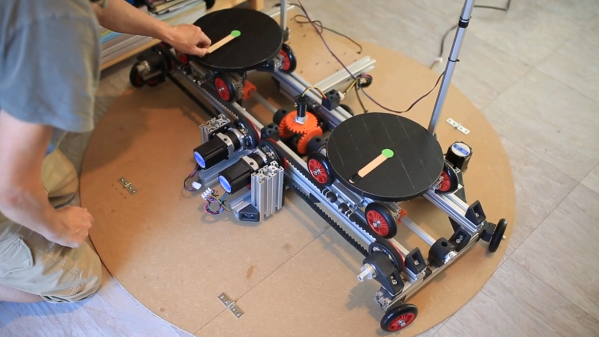Many of us have been asking for some time now “where are our robot servants?” We were promised this dream life of leisure and luxury, but we’re still waiting. Modern life is a very wasteful one, with items delivered to our doors with the click of a mouse, but the disposal of the packaging is still a manual affair. Wouldn’t it be great to be able to summon a robot to take the rubbish to the recycling, ideally have it fetch a beer at the same time? [James Bruton] shares this dream, and with his extensive robotics skillset, came up with the perfect solution; behold the Binbot 9000. (Video, embedded below the break)
Robots Hacks2427 Articles
Ply Your Craft With Tubular Origami
Researchers at the University of Pennsylvania have just published a paper on creating modular tubular origami machines which they call “Kinegami”, a portmanteau of “kinematic” and “origami”.

The idea behind their work is to create individual modules and joint mechanisms that can then be chained together to create a larger “serial” robot. Some example joints they propose are “prismatic” joints, allowing for linear motion, and “revolute” joints, which allow for rotational motion. One of the more exciting aspects of this process is that the joint mechanisms are origami-like structures which can be constructed from a single piece of flat material which is folded and glued together to make the module. Of particular interest is that the crease pattern for the origami-like folds can be laser cut into a material, cardboard or thin acrylic for example, which can be used as a guide to create the resulting structure. The crease patterns for the supporting structures, such as tubes or joints, can be taken from pre-formatted patterns or customized, so this method is very accessible to the hobbyist and could allow for a rich new method of rapid project prototyping.
The researchers go on to discuss how to create the composition of modules from a specification of joints and links (from a “Denavit-Hartenberg” specification) to attaching the junctures together while respecting curvature constraints (via the “Dubins path”). Their paper offers the gritty details along with the available accompanying source files. Origami hacking is a favorite subject of ours and we’ve featured articles on the use of origami in medical technology to creating inflatable actuators.
Video after the break!
Simple Mod Lets Quadruped Robot Stand And Walk
When it comes to locomotion, robots don’t typically do more than one thing at a time. Walkers stick to walking, and rollers stick to rolling. However, this simple method of enabling a cheetah-style quadruped to stand and even walk a little is pretty clever.
With just a couple of rigid struts attached to the shins of the rear legs, it becomes possible for the robot to lever itself up into a stable standing position, and even shuffle around a bit. Not bad for a couple bolted-on bits with no moving parts!
The robot style will look pretty familiar to some of our readers. It does resemble Boston Dynamics’ Spot but it’s closer to the MIT Mini Cheetah, whose design and brushless motors made for eye-catching agility and speed. It has inspired not just countless DIY efforts, but also kits of parts from overseas sellers.
The image here should make it clear how it works, but take a moment to also watch the short video embedded just below the page break, and see the process in action from beginning to end.
Continue reading “Simple Mod Lets Quadruped Robot Stand And Walk”
DIY Robotic Platform Aims To Solve Walking In VR
[Mark Dufour]’s TACO VR project is a sort of robotic platform that mimics an omnidirectional treadmill, and aims to provide a compact and easily transportable way to allow a user to walk naturally in VR.
 Unenthusiastic about most solutions for allowing a user to walk in VR, [Mark] took a completely different approach. The result is a robotic platform that fits inside a small area whose sides fold up for transport; when packed up, it resembles a taco. When deployed, the idea is to have two disc-like platforms always stay under a user’s feet, keeping the user in one place while they otherwise walk normally.
Unenthusiastic about most solutions for allowing a user to walk in VR, [Mark] took a completely different approach. The result is a robotic platform that fits inside a small area whose sides fold up for transport; when packed up, it resembles a taco. When deployed, the idea is to have two disc-like platforms always stay under a user’s feet, keeping the user in one place while they otherwise walk normally.
It’s an ambitious project, but [Mark] is up to the task and the project’s GitHub respository has everything needed to stay up to date, or get involved yourself. The hardware is mainly focused on functionality right now; certainly a fall or stumble while using the prototype looks like it would be uncomfortable at the very best, but the idea is innovative. Continue reading “DIY Robotic Platform Aims To Solve Walking In VR”
A Muppet On A Tricycle
[Donald Bell] wanted to recreate the magic of seeing Kermit on a tricycle from a 2018 NY Maker Faire he attended, so he created his own take of a Muppet on a Radio Flyer kids tricycle bike.

He started by attaching a ready made puppet to a classic Radio Flyer dual deck toddler tricycle using zip ties and split pipe insulation to give the limbs stiffness. [Donald] then put all the electronics, including the 12 V 50 RPM DC motor, 24 V 22.4 Ah Li-Ion battery pack, TB67H420FTG motor driver, and the Arduino Uno microcontroller under the back axle.
The motor transfers power to one of the back wheels via pulleys and timing belts with an additional ASMC-04B 24 V servo used to steer the tricycle via a steel pushrod. The RC communication is done with a FlySky FS-GT2 2.4 GHz 2-channel system. [Donald] gives a detailed list of parts that he uses in a Google doc for anyone wanting to know more.
[Donald] goes into great length about the limitations of the build, including the low clearance of the electronics underneath, the finicky nature of the timing belts and the “uncanny valley” that the size of the puppet induces to a casual observer. Regardless, the build is exceptional and paves the way for a variety of improvements for anyone wanting to extend the idea either further into the creepy or cute domain.
Retrofitting vehicles with motorized control are a crowd favorite, as seen with some projects like a stroller controller from Maker Faires of the past.
Robot Gets A Life-Sized Pokemon Costume For Halloween
Quadruped robots are everywhere now that companies like Boston Dynamics are shipping smaller models in big numbers. [Dave’s Armoury] had one such robot, and wanted to give it a Pokemon Halloween costume. Thus, the robot dog got a Jolteon costume that truly looks fantastic. (Video, embedded below.)

The robot in question is a Unitree Go1, which [Dave] had on loan from InDro robotics. Thus, the costume couldn’t damage or majorly alter the robot in any way. Jolteon was chosen from the original 150 Pokemon as it had the right proportions to suit the robot, and its electric theme fitted [Dave’s] YouTube channel.
A 3D model of Jolteon was sourced online and modified to create a printable head for the robot application. Two 3D printers and 200 hours of printing time later, and [Dave] had all the parts he needed. Plenty of CA glue was used to join all the parts together with some finishing required to make sure seams and edges didn’t spoil the finish too much. Wood filler and spray paint were used to get the costume looking just like the real Pokemon. Continue reading “Robot Gets A Life-Sized Pokemon Costume For Halloween”
3-DOF Robot Arm Wrist Without The Motor Weight
A major challenge of robotic arms is the weight of the actuators, especially closer to the end of the arm. The long lever arm means more torque is required from the other actuators, and everything flexes a bit more. To get around this, [RoTechnic] moved the wrist stepper motors off the arms entirely.
He built a push-pull mechanism that uses braided fishing line to transfer motion to the robot arm’s wrist using Bowden tubes. The motors are mounted on the arm’s base, with a drum and two lengths of fishing line on the shafts. The lines pass through an adjustable tensioner before entering the Bowden tubes. This drum mechanism is also present on each of the three rotating axes of the wrist.
[RoTechnic] used an Arduino-powered RAMPS board as a controller, which is programmed to accept over the serial interface. He created a simple GUI and scripting interface in Jupyter Labs to generate and send command, which seems like an excellent solution for testing.
We can see this mechanism being a useful for a variety of motion applications, and definitely something to add to the idea toolbox. It is somewhat similar to some other cable-operated joints we’ve seen in humanoid robots and other 3D printed arms.
Continue reading “3-DOF Robot Arm Wrist Without The Motor Weight”

















